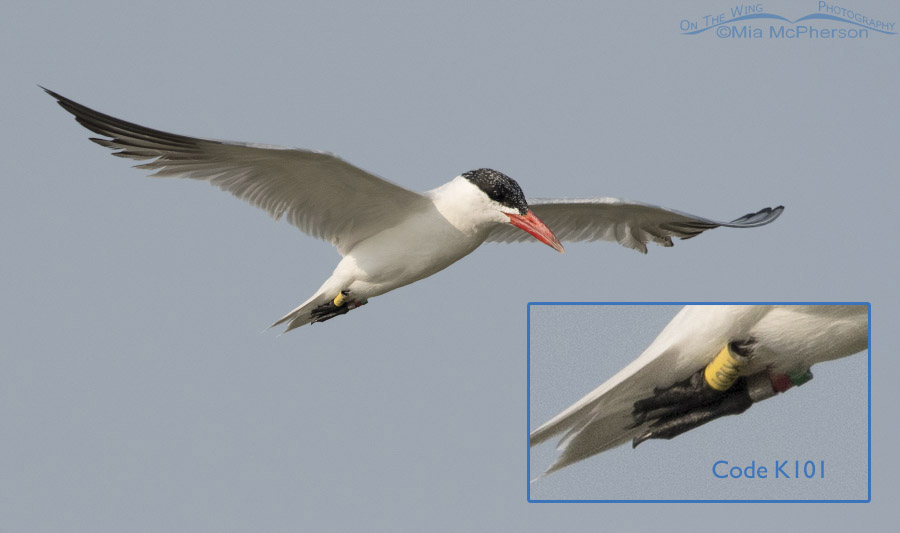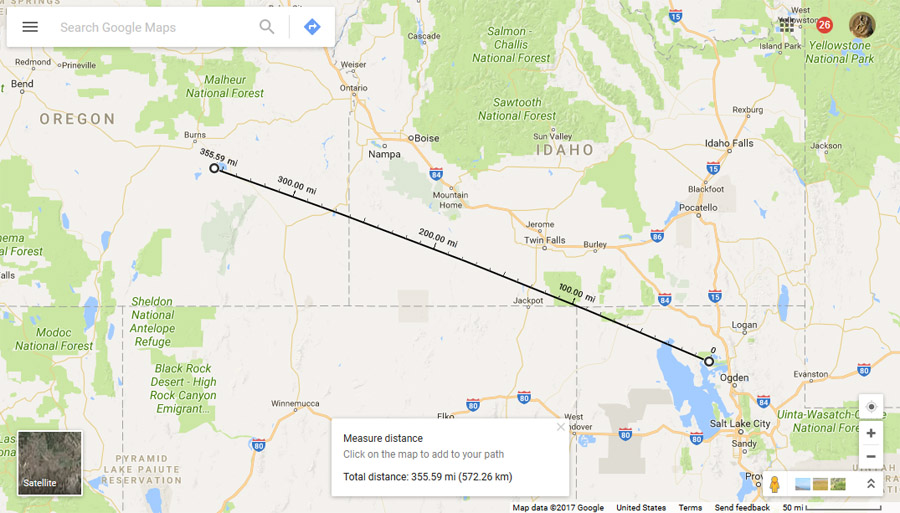 Caspian Tern Band K101 in flight over Bear River MBR with insert – Nikon D500, f7.1, 1/4000, ISO 640, Nikkor 500mm VR with 1.4x TC, natural light
Caspian Tern Band K101 in flight over Bear River MBR with insert – Nikon D500, f7.1, 1/4000, ISO 640, Nikkor 500mm VR with 1.4x TC, natural light
While attempting to photograph Forster’s Terns in flight and diving for prey at Bear River Migratory Bird Refuge on September 5, 2017 I also photographed one other tern species, a Caspian Tern that I spotted flying towards me caught my eye and I started photographing it from a long way away in the hopes it would fly in in closer.
Although I didn’t see it at the time I photographed this bird in flight the Caspian Tern did fly in close enough for me to capture images that showed it had bands on its legs. Yesterday I reported the band to two locations, BRNW Banded Birds – Caspian Terns and to the official Federal Government site at https://www.pwrc.usgs.gov/BBL/bblretrv/. The reason that I reported the tern to both sites is that the government site can take days, weeks or even months to send back information on banded birds and I hoped that the other site might be faster. I was right.
I heard back from Yasuko Suzuki, Postdoctoral Research Associate at the Oregon Cooperative Fish and Wildlife Research Unit, Department of Fisheries and Wildlife and Oregon State University in Corvallis, Oregon just a few hours later and she provided me with some information about the banded Caspian Tern I sighted flying over the marshes at Bear River Migratory Bird Refuge.
 Map showing distance between Malheur NWR and Bear River MBR
Map showing distance between Malheur NWR and Bear River MBR
Yasuko emailed me this information:
Hi Mia,
Thank you very much for reporting and sending photos of a banded Caspian tern from Utah! The bird was banded as a chick at Malheur Lake in eastern Oregon in 2012. It is great to learn he/she is spending some time in the Great Salt Lake area. The code does look KY01, but because all alphanumeric codes we have used are letter-number-number-number, I think it is K101.
If you happen to see the same bird again or any other color-banded Caspian terns, please let me know. Thank you again for your report!
Yasuko
Yasuko Suzuki
Postdoctoral Research Associate
Oregon Cooperative Fish and wildlife Research Unit
Department of Fisheries and Wildlife
Oregon State University
104 Nash Hall
Corvallis, OR 97331
When I sent in my report I wasn’t 100% sure about all of the characters in the code on the band, I could easily make out the K, the second character looked like a Y to me because of the shadow on the band, I could make out the O as the third character and the last character I thought could be a 1, Y or a 7. I am glad Yasuko was able to make out the code from the images I had attached to my report. When I look at the images now I can clearly make out the K101.
It tickled me to know that the Caspian Tern I found had been banded at Malheur National Wildlife Refuge and showed up at Bear River Migratory Bird Refuge five years later and that it had come from one of our National Wildlife Refuges in Oregon to another one of our National Wildlife Refuges in Utah. This tern hatched on our public lands and I found it again on more of our public lands.
I’ve been reporting banded bird sightings since around 2005, at the time I lived in Florida and saw banded Red Knots and other banded birds quite often. I don’t see nearly as many banded birds here in Utah as I did there but when I do and report them I am always excited to get information back on where the bird was banded, how old it was and if it had been resighted in between banding and my report.
Maybe I will find this Caspian Tern (they can live 25 years) or one of the other terns banded at Malheur again one day, you never know what you will see or find while out photographing birds.
Life is good.
Mia
Click here to see more of my Caspian Tern photos plus facts and information about this species.


Great shot and very interesting narrative. Thanks Mia.
Beautiful shot of bird…not too crazy about jewelry…even though I understand the reason and value of it…
I hope you do see this tern again. And it’s non-banded offspring.
Interesting post and nice image. Also appreciate the map. Thanks Mia!
It’s quite astounding how many things had to all be in place for this little adventure to occur. The bird had to be unlucky enough (from it’s perspective probably) to be trapped and banded. Then it traveled who knows how far since 2012 to end up at Bear River, to fly in the proximity of an intrepid avian photographer, who had her camera setup just right, to capture the letters and numbers on a leg band, that happened to be rotated in just the right orientation so that the light from the sun could show the markings. But, upon reflection, each moment of life is like that if we’re paying attention, as Mary Oliver says.
I have always thought it would be cool to band the birds we release from rehab, but most rehabers don’t like banding. I think It might show a high failure rate. I would like to see if they survive, how long and how far they might travel. Plus I would feel like rehabbing did make a difference in the one birds life who survived and it’s progeny.
How cool to have a little of the bird’s backstory! Hopefully, this tern can enjoy our public lands for many years to come.